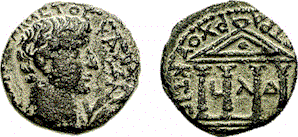There is little personal information
on Herod's
third heir except the name of his mother [Cleopatra of Jerusalem] & the fact that the
king's will (4
BCE)
made him administrator of Gaulanitis
[Golan],
Batanea & Trachonitis, regions in southwestern Syria & the
Lebanese mountains that Augustus
had added to Herod's jurisdiction two decades earlier (23-20
BCE). Like the
territory assigned his half-brother Antipas,
Philip's domain comprised about a quarter of the area of Herod's
kingdom & was the least heavily Judaized. Like Antipas, Philip
honored his Roman patrons by founding cities dedicated to the
imperial family. Paneas, an ancient spa & pagan shrine at the
source of the Jordan river, became Philip's imperial capital [Caesarea
Philippi], while the fishing
port of Bethsaida
on the northeast shore of Lake
Gennesaret was enlarged &
renamed Julias to honor the wife of Augustus [Livia, who styled
herself Julia Augusta]. He was married to Salome
II, who was daughter of his
half-brother Herod
II by his niece, Herodias.
But he died without heirs & his domain was given to Herodias'
brother, Agrippa
I.
Secondary literature,
such as Easton's
Bible Dictionary, has often referred to him as "Herod
Philip" although
there is absolutely no evidence in primary sources that he mimicked his
half-brother Antipas in claiming his father's name or was
addressed as Herod by contemporaries. This is a convenient
modern convention to distinguish him
from other ancient Hellenized rulers with the same given name.
References:
Josephus,
Antiquities
17.21,
27,
146,
189,
318-319;
18.106-108,
137,
237.
_____, War
2.94-95,
168.
Luke 3:1
Other resources on line:
![]()
![]()

![]()
![]()
![]() Perspective on the World of Jesus
Perspective on the World of Jesus ![]()